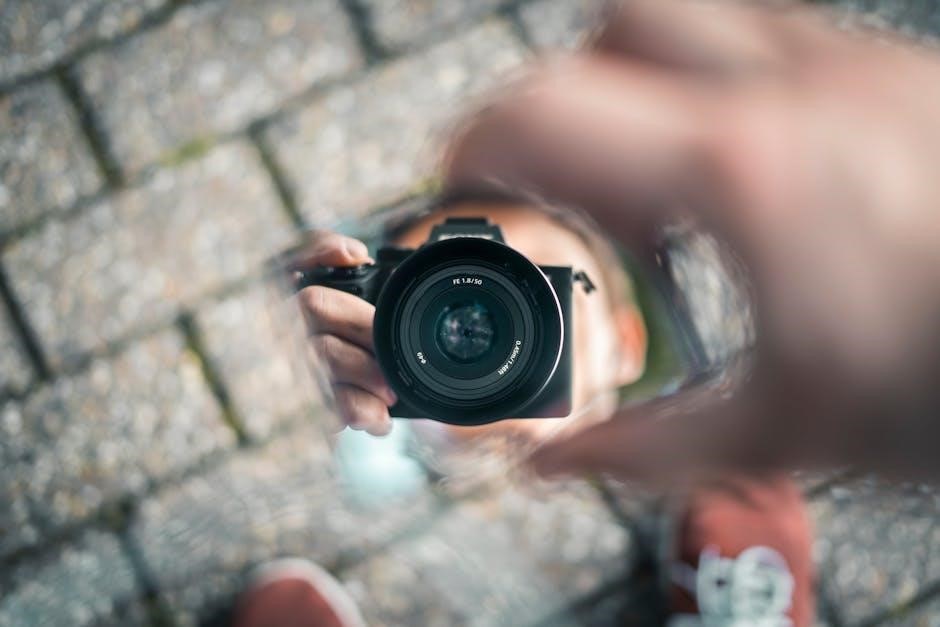
Ski goggle lens color enhances vision, protects eyes, and boosts performance. This guide explains how to choose the right tint for varying snow conditions.
Why Lens Color Matters for Skiing and Snowboarding
Lens color in ski goggles plays a critical role in enhancing visibility, reducing glare, and improving contrast in various snow conditions. Different tints are designed to optimize vision by filtering specific wavelengths of light, ensuring clarity and reducing eye strain. For instance, darker tints like grey or black are ideal for bright, sunny days, while lighter tints such as amber or yellow enhance visibility in low-light or flat-light conditions. Additionally, mirror-coated lenses reduce glare from reflective snow surfaces. The right lens color not only boosts performance but also ensures safety by providing crisp, clear vision, allowing skiers and snowboarders to react quickly to terrain changes. Proper tint selection is essential for adapting to changing weather and light conditions on the slopes.
Understanding VLT (Visible Light Transmission)
VLT measures the light transmitted through goggle lenses, crucial for optimizing vision in varying snow conditions by balancing brightness, clarity, and eye comfort for skiers and snowboarders.
What is VLT and Its Importance
Visible Light Transmission (VLT) measures the percentage of light passing through a goggle lens. It determines how bright or dim the environment appears, ensuring optimal visibility and comfort. Higher VLT allows more light, ideal for low-light conditions, while lower VLT reduces glare in bright settings, enhancing clarity. Proper VLT selection is crucial for skiers and snowboarders, as it directly impacts performance and safety by reducing eye strain and improving reaction time. Understanding VLT helps choose the best lens for varying weather and lighting conditions, ensuring clear vision and a superior on-slope experience.
How to Choose the Right VLT for Different Conditions

Selecting the correct VLT for skiing or snowboarding involves matching light transmission to weather conditions. For bright, sunny days, lower VLT (around 20-40%) reduces glare and enhances contrast. In low-light or flat light conditions, higher VLT (50-80%) improves visibility. Snowfall or overcast skies benefit from medium VLT (30-50%) for balanced lighting. Consider personal preference and specific activities, as VLT affects visual clarity and comfort. Proper VLT selection ensures optimal performance and safety, reducing eye strain and improving reaction time across diverse environments.

Popular Ski Goggle Lens Colors and Their Uses
Popular ski goggle lens colors include amber, yellow, rose, blue, mirror-coated, grey, and green. Each color enhances vision under specific snow and light conditions.
Amber and Yellow Lenses: Enhanced Contrast in Low Light
Amber and yellow ski goggle lenses are ideal for low-light conditions, enhancing contrast and reducing haze. They improve visibility in flat light and snowfall, making them perfect for overcast days. These tints amplify available light, helping skiers and snowboarders see definition in snowy terrain. Amber lenses often have a medium VLT, balancing light transmission and glare reduction, while yellow lenses are slightly lighter, offering more brightness without sacrificing clarity. Both options are excellent for early morning or late afternoon skiing when natural light is limited. They are a go-to choice for riders seeking better depth perception in challenging, low-light environments.
Rose and Pink Lenses: Versatility for Mixed Conditions
Rose and pink lenses offer exceptional versatility, performing well in mixed light conditions. They provide enhanced contrast and reduce eye strain while maintaining color accuracy. These tints are ideal for skiers who experience varying light throughout the day, from overcast skies to partial sunlight. Rose lenses typically have a medium VLT, making them suitable for both bright and low-light environments. Pink lenses, with slightly higher VLT, are better for cloudier days but still effective in moderate light. Both options are popular among riders who need a balance between visibility and glare protection, ensuring optimal performance across diverse weather conditions on the mountain.
Blue and Mirror-Coated Lenses: Reducing Glare in Bright Light
Blue and mirror-coated lenses are designed to minimize glare in bright, sunny conditions, making them ideal for clear days on the slopes. Blue lenses specifically block blue light, which is prevalent in sunny environments, reducing eye strain. Mirror coatings further enhance glare reduction by reflecting intense light away from the eyes. These lenses often have lower VLT, ensuring better light control and improved visibility. They are particularly favored by skiers and snowboarders in high-altitude or snowy regions where sunlight can be intense. However, they may not perform as well in low-light conditions, making them a great choice for riders prioritizing glare protection in bright settings.
Grey and Black Lenses: Neutral Color Perception in Bright Conditions
Grey and black lenses are excellent for bright, sunny conditions, offering neutral color perception while reducing glare. These lenses minimize light intensity without altering color accuracy, making them ideal for skiers who prefer a natural view. With lower VLT, they effectively block excessive light, providing sharp vision and reducing eye fatigue. Grey lenses are particularly popular as they maintain true-to-life colors, while black lenses offer the darkest tint for extreme brightness. Both are perfect for clear days, high altitudes, or reflective snow surfaces, ensuring optimal clarity and comfort in intense light conditions. They are a versatile choice for riders seeking precision and UV protection in sunny environments.
Green Lenses: Balancing Contrast and UV Protection
Green lenses strike a balance between contrast enhancement and UV protection, making them a versatile choice for skiers. They provide natural color perception while reducing glare and eye strain. With a moderate VLT, green lenses perform well in medium to bright light conditions, offering clear vision and sharp details. Their ability to enhance contrast improves depth perception, which is crucial for navigating varied terrain. Additionally, green lenses are effective at blocking harmful UV rays, safeguarding your eyes from potential damage. This makes them an excellent option for skiers who prioritize both visual clarity and eye health in a wide range of lighting environments.

Weather and Lighting Conditions Guide
Understand how weather and light impact your vision on the slopes. This guide helps you select the best lens colors for varying conditions, ensuring optimal visibility and comfort.
Bright Sunny Conditions: Best Lens Colors
In bright sunny conditions, darker lens tints are ideal for reducing glare and protecting your eyes from intense UV rays. Dark grey, black, or mirror-coated lenses are excellent choices, as they minimize eye strain and enhance contrast. These tints block a higher percentage of visible light, making them perfect for sunny days on the slopes. Additionally, lenses with a heavy mirror coating can further reduce glare by reflecting sunlight away from your eyes. For optimal performance, look for lenses with a lower VLT (around 10-20%) to ensure superior protection and clarity in bright environments. This combination ensures crisp vision and comfort, allowing you to enjoy your skiing or snowboarding experience without distractions.
Low Light and Flat Light Conditions: Optimal Lens Choices
Low light and flat light conditions require lenses that maximize visibility and contrast. Amber, yellow, or rose-tinted lenses are ideal, as they enhance contrast and reduce haze. These tints help skiers and snowboarders see definition in snowy terrain when natural light is limited. For flat light, such as during snowfall or overcast skies, opt for lenses with higher VLT (Visible Light Transmission), typically above 50-60%. This allows more light to reach your eyes, improving clarity and depth perception. Avoid dark or mirror-coated lenses in these conditions, as they can worsen visibility. Instead, prioritize tints that enhance low-light performance, ensuring safer and more enjoyable skiing or snowboarding experiences in challenging weather.
Snowfall and Overcast Skies: Recommended Tints
Snowfall and overcast skies create challenging visibility, requiring lenses that enhance contrast and reduce glare. Amber, yellow, or rose-tinted lenses with medium to high VLT (60-70%) are ideal. These tints improve definition in low-contrast environments, helping you spot terrain features more easily. Mirror-coated lenses can also reduce glare from reflected light in snowy conditions. For heavy snowfall, consider lenses with a hydrophobic coating to repel moisture. Avoid very dark tints, as they can worsen visibility in already dim lighting. Opting for lenses with anti-fog technology is also beneficial to maintain clear vision during prolonged snowfall or overcast weather.

Special Features in Ski Goggle Lenses
Special features like mirror coatings and polarization enhance performance. Mirror-coated lenses reduce glare, while polarized options minimize reflections. Anti-fog treatments ensure clear vision in moist conditions.
Mirror-Coated Lenses: Benefits and Drawbacks
Mirror-coated lenses reduce glare by reflecting light away from the eyes, enhancing visibility in bright conditions. They are ideal for sunny days on the slopes. However, the mirror coating can scratch easily, requiring extra care. Additionally, some users find the reflective appearance less appealing. Despite these drawbacks, mirror-coated lenses remain popular for their ability to improve optical clarity and reduce eye strain caused by intense sunlight. When choosing, consider durability and personal style, as the benefits often outweigh the minor inconveniences for many skiers and snowboarders.
Polarized Lenses: Reducing Glare on Snow
Polarized lenses are designed to reduce glare from reflective surfaces like snow, enhancing visibility for skiers and snowboarders. They work by blocking horizontally polarized light, which reduces eye strain and improves optical clarity. This is particularly beneficial in sunny conditions, where glare can be intense. Additionally, polarized lenses often enhance color perception and reduce eye fatigue, making them a popular choice for outdoor enthusiasts. However, they may not perform well in low-light conditions and could require extra care due to their specialized coating. Overall, polarized lenses are a great option for those seeking to minimize glare and enhance their experience on the slopes.

Choosing the Right Lens for Your Needs
Selecting the ideal ski goggle lens involves considering weather conditions, light levels, and personal preferences to optimize clarity and comfort for an enhanced skiing experience.
How to Select Lenses Based on Weather Conditions
When selecting ski goggle lenses, weather conditions play a crucial role. For bright, sunny days, dark-tinted lenses like grey or black with high UV protection are ideal as they reduce glare and enhance contrast. In low-light or flat-light conditions, opt for yellow or amber lenses to improve visibility. During snowfall or overcast skies, rose or pink tints offer versatility, enhancing contrast without over-darkening the view. Mirror-coated lenses can also be beneficial in bright light, reflecting sunlight and reducing eye strain. Always consider the specific weather conditions you’ll encounter to ensure optimal vision and comfort on the slopes.
Considering Personal Preference and Skiing Style
Personal preference and skiing style significantly influence lens selection. Casual skiers may prefer neutral tints like grey or green for natural color perception, while aggressive skiers might opt for high-contrast lenses like amber or rose to enhance visibility. Consider your sensitivity to light and how often you ski in varying conditions. Some riders prefer mirror-coated lenses for style and glare reduction, while others prioritize functionality over aesthetics. Ultimately, choose a lens that aligns with your skiing habits, personal comfort, and visual needs to ensure optimal performance and enjoyment on the slopes.

Maintenance and Care of Ski Goggle Lenses
Proper care ensures longevity and clarity. Clean lenses with soft cloths, avoid chemicals, store in protective cases, and keep them dry to prevent scratches and damage.
How to Clean and Store Your Lenses
Proper cleaning and storage are essential for maintaining ski goggle lens clarity and longevity. Use a soft, dry microfiber cloth to wipe away dirt and moisture, avoiding harsh chemicals or abrasive materials that can scratch the surface. For stubborn smudges, lightly dampen the cloth with water, but never apply liquids directly to the lenses. Store lenses in a protective case when not in use to prevent scratches and damage. Avoid placing goggles in extreme temperatures or direct sunlight, as this can degrade lens coatings over time. Regular maintenance ensures optimal performance and preserves the tint’s effectiveness in various skiing conditions.

Preventing Scratches and Extending Lens Life
Preventing scratches and extending lens life requires careful handling and storage. Always handle lenses by the frame, avoiding direct contact with the surface to prevent oils from skin causing smudges. Use a soft, dry microfiber cloth for cleaning, and avoid harsh chemicals or abrasive materials that can damage coatings. Store lenses in a protective case when not in use to shield them from scratches and environmental damage. Regularly inspect lenses for minor scratches and address them promptly to prevent further damage. By following these steps, you can maintain the integrity and performance of your ski goggle lenses, ensuring they remain effective for years to come.
Choosing the right ski goggle lens color is crucial for optimal vision. This guide helps you select lenses that enhance clarity, contrast, and UV protection. Invest wisely;
Final Tips for Picking the Perfect Ski Goggle Lens Color
When selecting ski goggle lenses, prioritize your skiing conditions and personal preferences. For bright days, opt for dark or mirrored lenses to reduce glare. In low light, amber or rose tints enhance contrast. Consider multi-lens systems for versatility across varying conditions. Always check the VLT percentage to ensure optimal light transmission. Additionally, polarized lenses can minimize glare on snowy surfaces. Remember to balance style with functionality, ensuring your choice complements your skiing style and weather conditions. Proper care and maintenance will extend the life of your lenses, ensuring clear vision for seasons to come. Make an informed decision to elevate your skiing experience.






